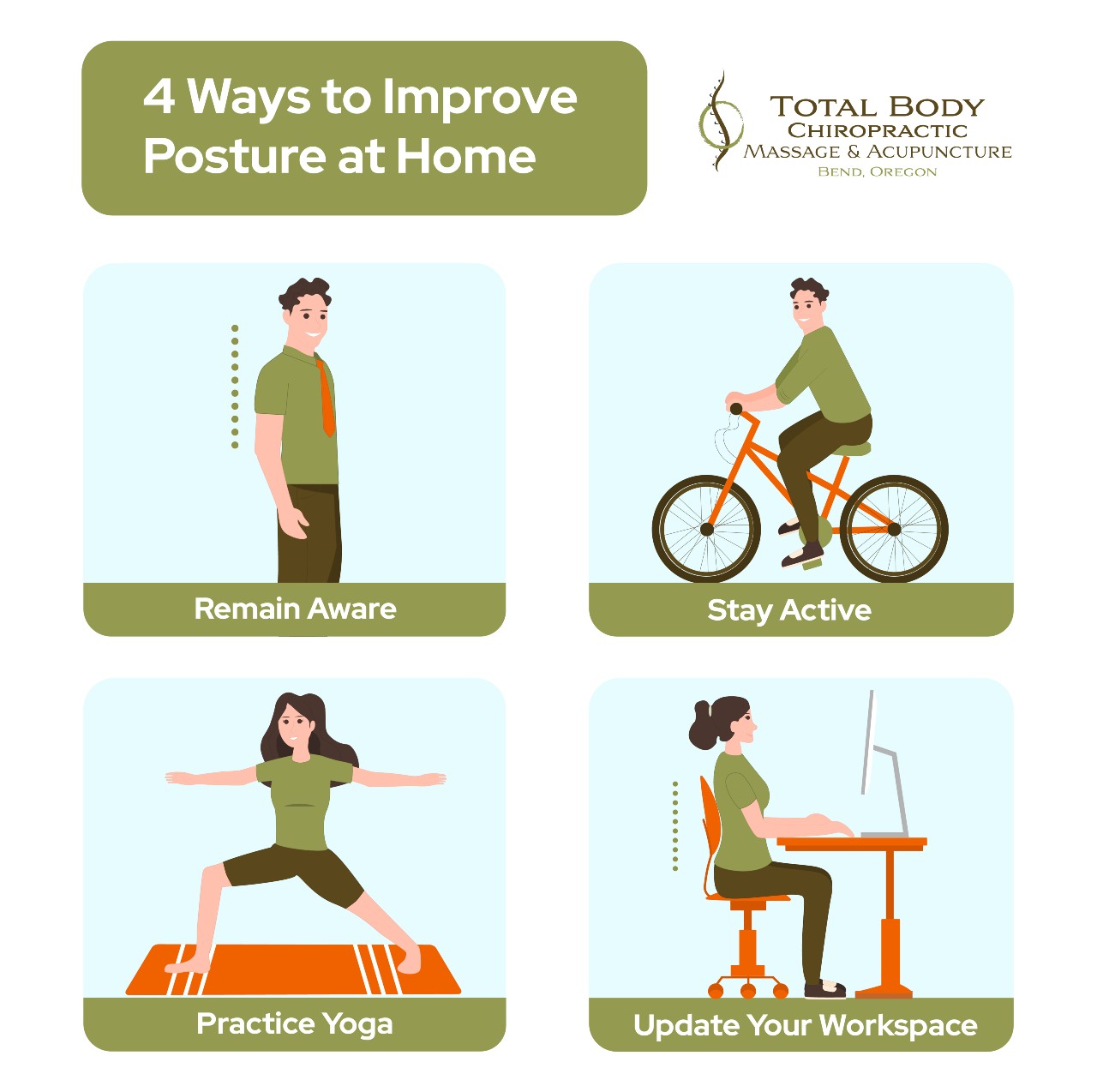Can a Chiropractor Help Your Posture?
Your parents have probably told you to “stand up straight” or “keep your shoulders back” more than a few times throughout the years. It may be annoying, but it’s a pretty helpful piece of advice. Nearly every U.S. adult will deal with bad posture at some point. Your posture impacts your overall health, from bones and joints to your sleep and digestion.
However, maintaining good posture is more than just standing upright. Daily stressors and occupational habits require you to take an active approach to fixing and maintaining your alignment. A combination of stretches, exercise, and regular chiropractic visits can keep your spine in the correct position.
Keep reading to learn whether you have bad posture, ways to fix your posture at home, and how a chiropractor can help with posture correction
Why is it Important to Have Good Posture?

Posture describes the position of your body when standing or sitting. When we say good posture, we really mean a neutral spine. In this position, the muscle groups, ligaments, and joints are aligned in a way that reduces stress and fatigue on your body. Good posture allows you to turn, twist, and move easily.
So, what does a healthy posture look and feel like? It should feel relaxed and comfortable. Your head should stack over your shoulders, and your shoulders over your hips, and finally, your hips over your ankles.
More specifically, stand with your chin parallel to the ground and keep your shoulders back with your arms sitting naturally at your side. You should keep your knees soft, and the weight between the balls of your feet and your heels. Tuck your stomach and roll your pelvis forward to keep your low back aligned.
Standing and sitting in the proper position has a number of benefits for your health:
- Increased comfort
- Fewer aches and pains in joints, neck, and back
- Reduced risk of injury and muscle strain
- Smoother digestion
- Better balance
- Greater Flexibility
- More restful sleep
What Causes Poor Posture?

Poor posture results from sitting or standing in awkward positions for prolonged periods. Certain lifestyle habits can also contribute to these structural spinal misalignments.
- Stress — Whether you have chronic stress or just deal with daily tensions, it can impact your posture. The shallow breathing and muscle contractions that accompany stress can compromise your body and cause tight muscles.
- Weight gain — Extra weight, especially in your abdominal area, pulls your pelvis forward, causing the low spine to curve too deeply. Not to mention, it puts more pressure on your hips, knees, and ankles, which affects your posture.
- Pregnancy — The added pressure on the spine, hips, and lower body affects posture, leading to complaints of low back pain. Proper posture can ease the pressure you feel during this time. After delivery, it’s necessary to readjust the body and put vertebrae and joints back into place.
- Weak or tense muscles — When you have weak muscles, like in the abdomen, other areas in the low back must work harder to support the spine. This tension impacts posture and causes pain.
In some cases, poor posture makes your body use its surface-level active muscles, which quickly run out of steam. The deeper muscles go unused and become weaker. They then tense up and shorten, compacting spinal bones and further worsening your posture.
- Injuries — When you get injured, muscles in the affected area will spasm in order to protect from further injury. However, this action limits movement and causes pain. Even after your injury has healed, your body may hold onto the unhealthy position.
- Shoe type — Your high heels may be contributing to your poor posture! These types of shoes shift your body weight forward and cause you to walk differently. Even ill-fitting flat shoes can negatively impact your alignment.
- Technology — Desk workers are at a disadvantage when it comes to postural problems. Looking down or up at a screen all day shifts your neck alignment. Handheld technology can make the problem more severe, as you’re more likely to bend your neck forward for too long. The resulting condition is commonly known as text neck and can cause neck pain and improper posture.
How Can You Tell if You Have Bad Posture?

Not only can you see poor posture, but you can certainly feel it. Most commonly you will notice hunched shoulders, rounded upper back, or an arched lower back. Other symptoms of bad posture and a misaligned spine include:
- Aches and pains, especially back, neck, and shoulder pain
- Muscle fatigue
- Increased risk of injury
- Bent knees when standing or walking
- Potbelly
- Headache
- Head leaning forward or backward
- Slowed digestion or heartburn, affecting your digestive tract
- Joint restrictions
Poor posture can also contribute to premature aging and associated conditions, like arthritis.
If you have bad posture, it may fall into one of four categories:
- Forward head — Where your ears tilt in front of your vertical midline
- Kyphosis — There is an exaggerated curve of the upper back. This form typically develops in boys.
- Lordosis, or hyperlordosis — This posture, also known as “sway” back, occurs when the hips and pelvis tilt forward.
- Flatback — When your lower spine loses its curve, the back appears flat.
Four Ways to Improve Posture at Home

Fortunately, it’s possible to improve your posture at home. Try these four tips throughout the day to fix your alignment.
1. Remain Aware — Regularly checking in on your body and posture is the most important step you can take toward improvement. When you start to feel your shoulders hunching, spine curving, or your lower back swaying forward, take a moment to adjust.
Imagine there’s a string running through your body to the crown of your head, and someone is pulling up on it. Even laying on the floor with your knees bent toward the sky or standing against a wall with your feet under you can aid in learning and maintaining correct posture. Add this practice into your daily activities and feel the health benefits.
2. Stay Active — Regular exercise can strengthen the weak and unused muscles that support the back. Weight training teaches you how to activate those deep and postural muscles. Not to mention, working out can help with weight management. Losing weight eases the stress that abdominal fat puts on the lower back, other joints, and your nervous system.
3. Yoga and Stretching — Yoga helps release muscle tension and lengthen shortened areas that may be affecting your vertebrae. Cat-cow, child’s pose, downward dog, and other basic yoga poses stretch your spine in all directions to boost overall health.
If you’ve been leaning one way, try stretching back in the opposite direction to neutralize the area. It gives overactive muscles a break.
4. Update Your Workspace and Use Support Devices — Invest in an ergonomic desk chair to support your posture while sitting. Your knees should sit at a right angle with feet flat on the ground. You can also use a small pillow to support your back at work.
Raise your computer to eye level. Your wrists should rest flat and comfortably against the keyboard. Click here for more tips on building an ergonomic workspace.
Keep in mind that it takes work and regular care to prevent your posture from returning to its unhealthy state. So, even once you’ve fixed your alignment, you’ll have to check in on it often.
Chiropractor Posture Correction
Of course, chiropractic care can help correct your posture! Using manual techniques, your Bend chiropractor will realign your spinal cord and joints to encourage spinal health.
Your visit will begin with an assessment of your symptoms and lifestyle, exercise, and work habits. During this process, your chiropractor will determine whether you have poor posture, the ways it’s affecting you, and how to fix it. All this information reveals the root cause.
Next, your chiropractor will do a hands-on assessment to figure out exactly what is wrong. They’ll look at how you stand from the front, back, and sides, checking for uneven shoulders, arched back, a twisted pelvis, and other symmetry issues.
Using a chiropractic adjustment, your doctor will find the proper alignment for your shoulders, spine, and neck. The spinal adjustment will increase your range of motion, reduce tension, and ease you into good posture.
Your chiropractor will also address problems with the muscles and soft tissues. Left unaddressed, your muscles will remain tense and continue pulling your spine and shoulders into unhealthy positions. Massage therapy can reduce this tightness and ease muscle spasms.
At the end of your visit, your chiropractor will suggest a treatment plan. While you will feel immediate relief after your appointment, you’ll need to get on a regimen for long-lasting results. Your body is likely used to its poor positioning, so it will try to return to the same state as before. At-home techniques coupled with chiropractic treatment will help to permanently create correct alignment and proper posture for good.
Chiropractic Treatment from Total Body Chiropractic
Even more than optimal health, chiropractic care for better posture can help you feel taller and more confident. At Total Body Chiropractic in Bend, we merge various treatment methods to help you feel your best. In the process of fixing your posture, we also address issues like allergies, headaches, hormonal imbalances, and so much more. Schedule your appointment and get on the road to better alignment today.
